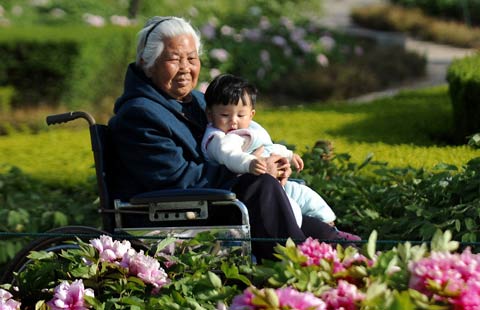Targeted investments help balance growth
Updated: 2014-12-05 11:21
By Mark Purdy and Jing Qiu(China Daily Europe)
|
|||||||||||
China isn't over-investing, it is distributing its capital to the wrong sectors
Investment in fixed assets - roads, buildings, machinery and other infrastructure - has powered China's economy for the last two decades. But at the same time, many commentators worry that China's growth model relies too heavily on increasingly inefficient investments and that, as a result, its economy has become dangerously unbalanced.
While seemingly compelling, the conventional over-investment story is misleading in certain respects. Accenture's research shows that on some measures China may need more capital, not less. However, the key issue facing China is the distribution of capital and how it is used. In fact, investments in the right areas can stimulate household consumption and provide an entirely new source of balanced growth.
Is China over-investing?
China's remarkable economic growth over the past decade has relied prominently on investment in fixed assets, which rose to 44 percent of GDP in 2012 from less than 30 percent in 1980. This share is much higher than those of other nations in the BRICS bloc (Brazil, Russia, India and South Africa) and developed economies.
Even taking into account the size of China's population, the country has accumulated capital at a staggering rate. For example, the nation's rate of capital deepening, or capital growth per person, has increased faster than in any other major economy during the past two decades. And in recent years, the pace has increased: In the last decade, China's capital stock per capita grew by over 11 percent a year, markedly faster than in other economies.
At the same time, many commentators now argue that this flood of capital has caused China's economy to become dangerously unbalanced. Some analysts point to oversupply in property markets, low prices and excess capacity in certain industries as further evidence of a capital spending glut.
As a result, many experts and Western governments have raised doubts about the sustainability of the investment-driven economic growth model. They say that China is over-investing and heading for a crash. While investment may be the bedrock of China's economic growth, experts worry that it could also become the nation's Achilles' heel.
Is that true?
It's not a problem in itself
The view that China is dangerously addicted to fixed investment seems compelling. But on closer examination, some key indicators relating to China's capital stock appear to be at odds with the conventional over-investment story. At the very least, they indicate a more complex picture where the key challenges relate to the distribution and use of capital rather than to volume alone.
Let's look at these indicators in turn.
Incremental capital to output ratio: It measures how efficiently an economy uses capital to create goods and services. A low ICOR indicates a relatively efficient use of capital: Fairly low capital expenditure is needed to produce additional output. As the data show, over the past three decades, at an aggregate economy level, China has seen some deterioration in the efficiency of investment but not dramatically so. From an international perspective, China's ICOR levels also look reasonable. If anything, China's ICOR is more stable and lower than those of other countries. Moreover, in recent years, China's annual capital efficiency has been better than that of the US, the UK, Japan, South Korea and Singapore.
Amount of capital per capita: The higher the amount of capital available to each person, the more the economy - and each person on average - can produce. China's amount of capital per person appears to contradict the idea that China is awash with capital. While capital per person has risen steadily over the last few years, it remains far below the levels seen in developed economies such as the US and Japan. In fact, it's only about 10 percent that of the US. On this reading, China has plenty more room to accumulate capital.
So, let's answer the question - Is China putting too much of its resources into capital accumulation? The ICOR and levels of capital per person suggest that the answer is no. China continues to deliver a high return on its investments and has a long way to go before maturity. In short, our research strongly suggests that capital will continue to be an important source of economic growth for China.
China's real capital crisis
How do we reconcile the conventional story of over-investment with some of the other indicators? If we look beyond the aggregate economy level to the sectoral level, a new picture emerges: China's real capital crisis is in how capital is distributed.
One sign that capital has been misallocated can be seen by looking at disparities in return on assets between state-owned and privately owned enterprises. On average, private enterprises have a higher return on assets than SOEs. This means that capital could be better utilized by private firms. Similarly, there is a gap in capital efficiency between China's small to medium-sized enterprises and large industrial enterprises. This tells us that capital could be better distributed to smaller firms, not least because they can generate better returns and are playing a critical role in the economy. However, SMEs remain starved of adequate funding. These findings suggest potential constraints on the distribution of capital that inhibit the flow of adequate financing to the most productive sectors and industries.
A review of China's infrastructural investments shows that more targeted allocation is needed. Take the example of transportation. Though China has made impressive strides in high-speed rail, it still needs to invest more in upgrading essential bus services and local railway networks. Investment in these areas will generate considerable returns.
Making capital count
If the capital challenge in China is essentially a distributional one, in what ways could the allocation of capital be significantly improved? What kinds of investments would generate the best returns in the long run?
We believe they include those that help small private businesses, raise living standards for the middle class and working poor, and build the country's knowledge and digital capital. The country could also make high-return investments in organizational decision-making and processes to improve capital productivity. In other words, China needs to put its enterprises - small and large - on the road to high performance. Organizations must ensure that their money is spent wisely - on improving people's livelihoods and stimulating business activity. Investments in technology and infrastructure must work in concert with business growth. In this respect, the economic reforms announced by the new leadership are an important step in the right direction.
In less than four decades, China has traversed a path that took the countries of the developed world a couple of centuries to travel. Now China is entering a new stage. Can China continue to grow rapidly? With business and policy leaders increasing their efforts to make capital count by investing it where it's needed most, it can.
The authors are researchers at Accenture Institute for High Performance. The views do not necessarily reflect those of China Daily.
|
Zhang Chengliang / China Daily |
(China Daily European Weekly 12/05/2014 page12)
Today's Top News
US, Britain pledge to support Afghanistan
HK visit: A political kabuki
Ukraine unlikely to join NATO in near future
Hotpot chain to raise $129m
2014 likely to be record warmest year
Ukraine's ceasefire talks continue
China marks 1st Constitution Day
Outbound tourists hit record 100m
Hot Topics
Lunar probe , China growth forecasts, Emission rules get tougher, China seen through 'colored lens', International board,
Editor's Picks

|

|

|

|

|

|






